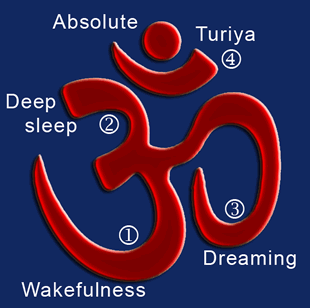turiya
Turiya, "the Fourth" (in relation to three states below)
— Pure Consciousness, both transcends and pervades the tree states of waking, dreaming, and deep sleep. "The Fourth" does not signify a numerical relationship with the three states. Turiya is called "the Fourth" because It occupies the fourth place in the order of exposition of Brahman.
 States of consciousness and AUM:
States of consciousness and AUM:
1. waking
2. dream
3. deep sleep
4. turiya
![]()
Turiya cannot be described by any instrument of empirical knowledge, because of Its unique nature. It is devoid of all characteristics, specific or generic, being one and without a second. Being actionless, It cannot be described by any activity, such as creation, preservation, etc. Then, it may be asked, what purpose is served by the Knowledge of Turiya? Is it not something like the horns of a horse? Not at all.
When a person realizes his self to be Turiya, he is freed from craving for outer objects. He is freed from the false fear and false expectation which plague the phenomenal life. When one knows the true nature of the desert, one no longer runs after the illusory water of the mirage, and when one knows the true nature of the rope, one is not frightened by the idea of the snake falsely superimposed upon it. The realization of the self as Turiya destroys ignorance, desire, attachment, aversion, etc. The gist of the teachings of the Upanishads is the identity of the self and Turiya. Compare: “That thou art” (Chh. Up. VI. viii. 7); “This Atman is Brahman” (Ma. Up. 11); “Atman, indeed is all this” (Chh. Up. VII. vxx. 2). Turiya does not lie outside the three states. ...
It is like the immediate revelation of the rope when the illusory knowledge of the snake is destroyed. When the ignorance that veils the true nature of the rope disappears, the rope is known at once. The knowledge of the rope is not the result of the destruction of the idea of the snake; for the rope has always existed. No other instrument of knowledge is necessary to reveal the rope after the illusory idea of the snake has been destroyed. Likewise, the very destruction of such attributes as subjective consciousness and objective consciousness reveals the reality of Turiya, though the Knowledge of Turiya is not the direct result of the destruction of these attributes. No other instrument of knowledge is necessary for the realization of Turiya. When Turiya is realized, there no longer remains any distinction between the knower, knowledge, and the known. Therefore the purpose of the scriptures and other instruments of knowledge is to accomplish the cessation of the attributes mentioned in the text, which is simultaneous with the realization of Turiya. (The various instruments of knowledge employed to explain the non-duality of Brahman really belong to the sphere of duality. The purpose of these instruments is the destruction of duality. When duality is destroyed the instruments of knowledge are also destroyed. Then such factors of realization as the proof and the prover no longer remain. Only Brahman is.) (Swami Nikhilananda: The Upanishads Volume 2, p.237)
![]()
Turiya is not that which is conscious of the inner (subjective) world, nor that which is conscious of the outer (objective) world, nor that which is conscious of both, nor that which is a mass of consciousness. It is not simple consciousness nor is It unconsciousness. It is unperceived, unrelated, incomprehensible, uninferable, unthinkable and indescribable. The essence of the Consciousness manifesting as the self in the three states, It is the cessation of all phenomena; It is all peace, all bliss and non—dual. This is what is known as the Fourth (Turiya). This is Atman and this has to be realized. (Mandukya Upanishads VII )
Turiya, the changeless Ruler, is capable of destroying all miseries. All other entities being unreal, the non—dual Turiya alone is known as effulgent and all—pervading. (1.10)
![]()